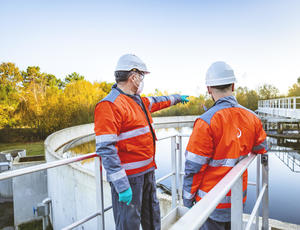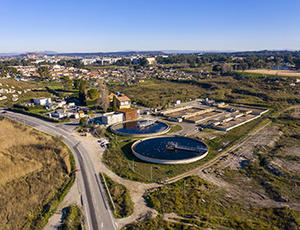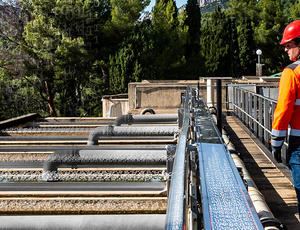Mectan™ is a vortex grit removal system that utilizes a circular grit chamber, rotational velocity, and extraction system to provide a complete grit removal process for wastewater treatment plants.
Overview
Grit consists of inert and organic abrasive particles such as sand and gravel which are between 50 and 200 MESH (a measurement of particle size used in determining the particle-size distribution of a granular material) and between 300 and 75 micrometers (µm) in diameter.
Historically, rectangular aerated grit removal systems were huge, resulting in high land, civil and equipment costs and an increased risk of equipment damage and failure.
Mectan is a grit removal system that offers an effective, integrated and complete vortex grit chamber designed to combat and prevent the common problems caused by grit. It can be used in industrial and municipal wastewater treatment and stormwater management.
How does Mectan work?
Grit capture
Wastewater enters the circular vortex grit chamber tangentially creating a controlled vortex flow. The Mectan vortex grit chamber is available in several configurations that each incorporate a circular top chamber where the vortex is created and a bottom grit well where the grit is collected.
The circular chamber is designed to handle daily water flow rates of up to 355,000 cubic metres per day (m3/d) or 78 million gallons per day (MGD) per unit in a fraction of the footprint of conventional aerated grit removal systems.
Grit removal process
The vortex grit chamber separates the grit by density using paddles and gravity forces to maintain rotational velocity and reduce turbulence. This causes heavier particles to settle at the bottom, while lighter organic materials and water remain suspended at the top.
Once the grit has been captured at the bottom of the vortex grit chamber, the grit also known as slurry, is extracted with a grit pump (hydro-cyclone) or an airlift system (air separator). The grit pump can be installed in a top-mounted or bottom-suction configuration. The airlift system can only be installed in the top-mounted configuration and is limited to smaller applications.
Grit concentration, washing and dewatering
The concentrated grit slurry is discharged into the Sam Type Grit Dewatering Screw (GDS) which washes the grit and reduces the water content through dewatering. The wastewater overflows from this process exits the system and is returned upstream of the vortex grit chamber for onward treatment.
The grit removal system operates continuously to efficiently separate grit from wastewater, protecting equipment and enhancing overall wastewater treatment plant performance.
With more than 400 units in operation around the world, wastewater treatment plant operators have trusted Mectan again and again for reliable grit removal processes.

Features and benefits
Operational efficiency and performance
- Efficient operation on a wide range of flow rates.
- Constant velocity assisted by paddles.
- The induced vortex paddle mixer design provides optimum grit removal conditions while limiting organics accumulation in the grit well.
- Sloped transition and rotating motion eliminate the accumulation of grit in the separation chamber under all conditions.
Cost-effectiveness and installation
- Low head loss and maintenance costs.
- The compact size results in low excavation and civil works costs.
- Retrofittable into existing plants.
Durability and maintenance
- Reliable robust design with simple mechanics.
- No moving parts are subject to wear or blockages located underwater.
- Full accessibility to grit collecting well.
Applications
Services
Resources & product range
Mectan Classic
The circular design will handle large flow rates in a fraction of the footprint of conventional aerated units. The grit is transferred from the grit well to the classifier via pump or air-lift.
Mectan V
Based on computational fluid dynamics analysis and real-world results, this new design increases efficiency (up to 20%) with the possibility to position the outlet channel in any desired direction. Features include increased grit removal, low power requirement and decreased carbon footprint.
BioMectan™
Advanced grit capture system with 95% efficiency for particles down to 75 microns. Features hydro-dynamic and vortex separation, high-shear mixing, and greywater reuse. Four models available for flows up to 13.4 MGD.
Contact
Mectan represents a leap forward in wastewater treatment efficiency. Its compact design and adaptive performance across variable flow rates not only enhance operational reliability but also significantly reduce the environmental footprint of treatment plants. By effectively removing grit, we're protecting downstream equipment, minimizing maintenance and ultimately contributing to more sustainable water management practices. It's a prime example of how innovative engineering can drive ecological transformation in urban infrastructure.

Aurélien Pauléat, P.Eng.
Equipment Tender Director - John Meunier products
Contact Aurélien throug his LinkedIn account
FAQ about Mectan
Why are grit removal systems important in wastewater treatment plants?
A grit removal process is crucial in a wastewater treatment plant to protect equipment and ensure system efficiency. Grit, including sand, gravel and other heavy inorganic particles, can cause excessive wear, blockages and damage to pumps, pipes and other machinery. Removing grit early, with an effective grit removal system that uses vortex grit removal technology, reduces maintenance costs, prevents downtime and prolongs equipment lifespan. Additionally, it minimizes the risk of sedimentation in tanks and pipes, improving the efficiency of subsequent treatment processes. Proper grit removal also helps maintain the quality of treated sludge by preventing inorganic contamination, ensuring safer reuse or disposal.
Why is sludge dewatering important at a wastewater treatment plant?
Sludge dewatering is vital at wastewater treatment as it reduces the water content of sludge, minimizing its volume and weight. This process lowers transportation and disposal costs, making waste management more efficient and economical.
By producing a drier, more manageable sludge, sludge dewatering systems can then reuse or dispose of it in an environmentally responsible way, such as incineration, land application or landfilling.
Additionally, it improves the performance of subsequent treatment processes, reduces odor pollution and contamination risks and conserves energy.
Case Studies

Reidsville's wastewater treatment plant faced critical vulnerabilities due to extreme weather events, as demonstrated by Hurricane Michael's impact in 2018. The existing headworks system was prone to failure during severe conditions, causing hazardous raw sewage overflows and posing significant environmental and public health risks. To respond to the urgent need for a more resilient and reliable wastewater treatment infrastructure, we proposed a comprehensive upgrade featuring two state-of-the-art Mectan V units. Designed to enhance resilience against extreme weather, prevent sewage overflows and improve overall operational efficiency and reliability, it strategically relocates the new headworks system out of the floodplain. It significantly reduces the risk of weather-related failures, providing Reidsville with a robust, future-proof wastewater treatment system, safeguarding public health and the environment.

The city of Kitchener, Ontario, initiated a major upgrade of its wastewater treatment infrastructure to meet growing demands and improve environmental performance. This project, based on the region's 2007 wastewater master plan, aimed to modernize treatment services for long-term sustainability, while meeting strict environmental standards. A key component was the installation of a new headworks system with two advanced Mectan units. The upgrade was designed to accommodate population growth, enhance treatment standards, optimize efficiency, and reduce energy use. It also focused on minimizing odors, improving effluent quality and increasing plant reliability.
This forward-thinking approach demonstrates the city's dedication to public health, environmental stewardship and sustainable urban development, setting a new benchmark for wastewater treatment in the region.

Malibu faced a critical need to modernize its wastewater management in the Civic Center area, balancing urban development with stringent environmental standards. The city required a solution that could effectively treat, reuse and dispose of wastewater from local properties while maintaining its commitment to ecological sustainability. In response to this challenge, we contributed to Malibu's largest public infrastructure project in 2016, focusing on comprehensive upgrades to the Civic Center wastewater treatment plant. Our approach centered on implementing cutting-edge technologies across the entire water treatment chain, including the installation of an advanced Mectan V unit in the headworks.
By integrating advanced technologies, we helped Malibu create an environmentally friendly wastewater treatment system that not only meets current needs but also supports sustainable urban growth, setting a new standard for eco-conscious municipal infrastructure.









